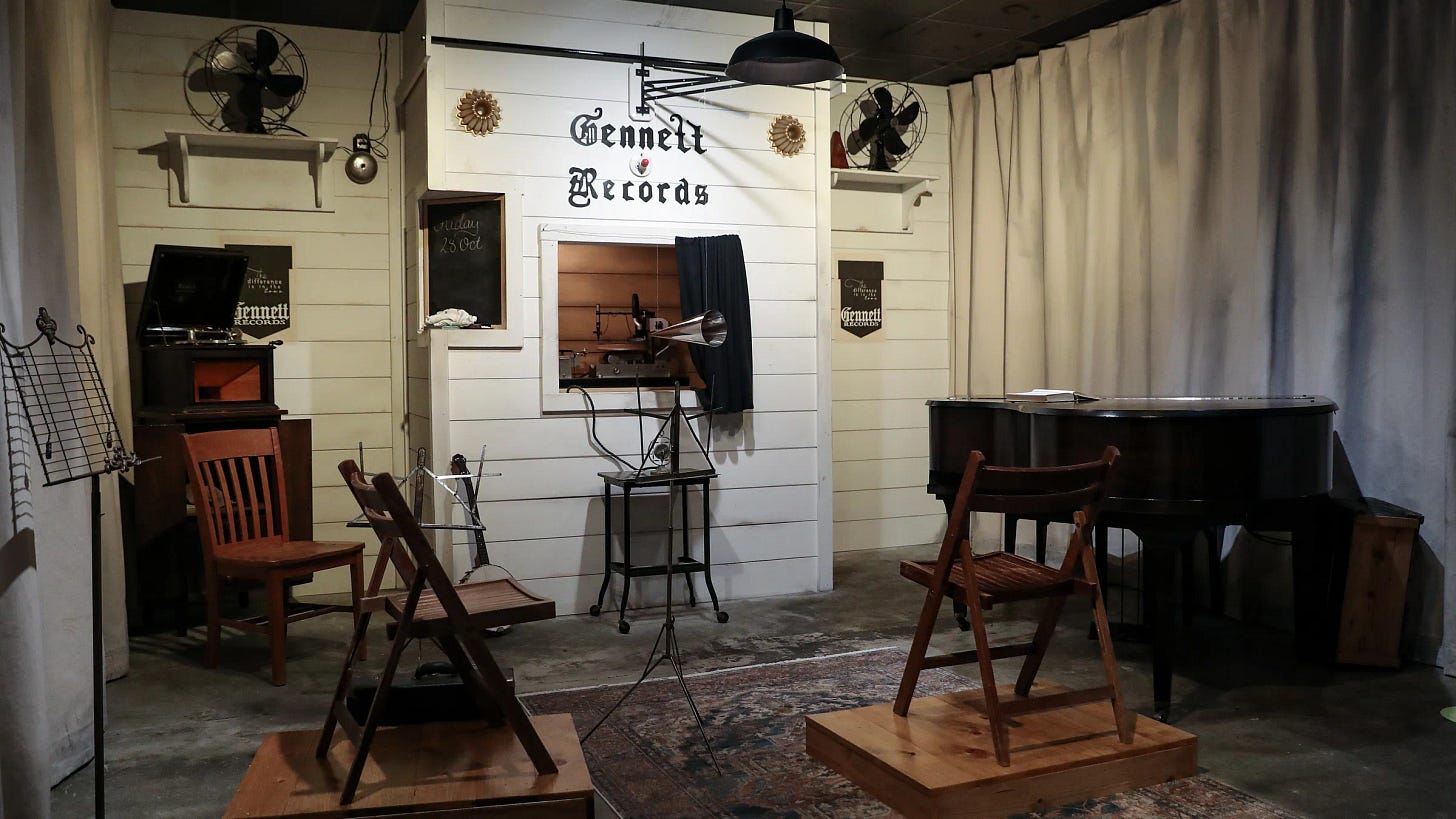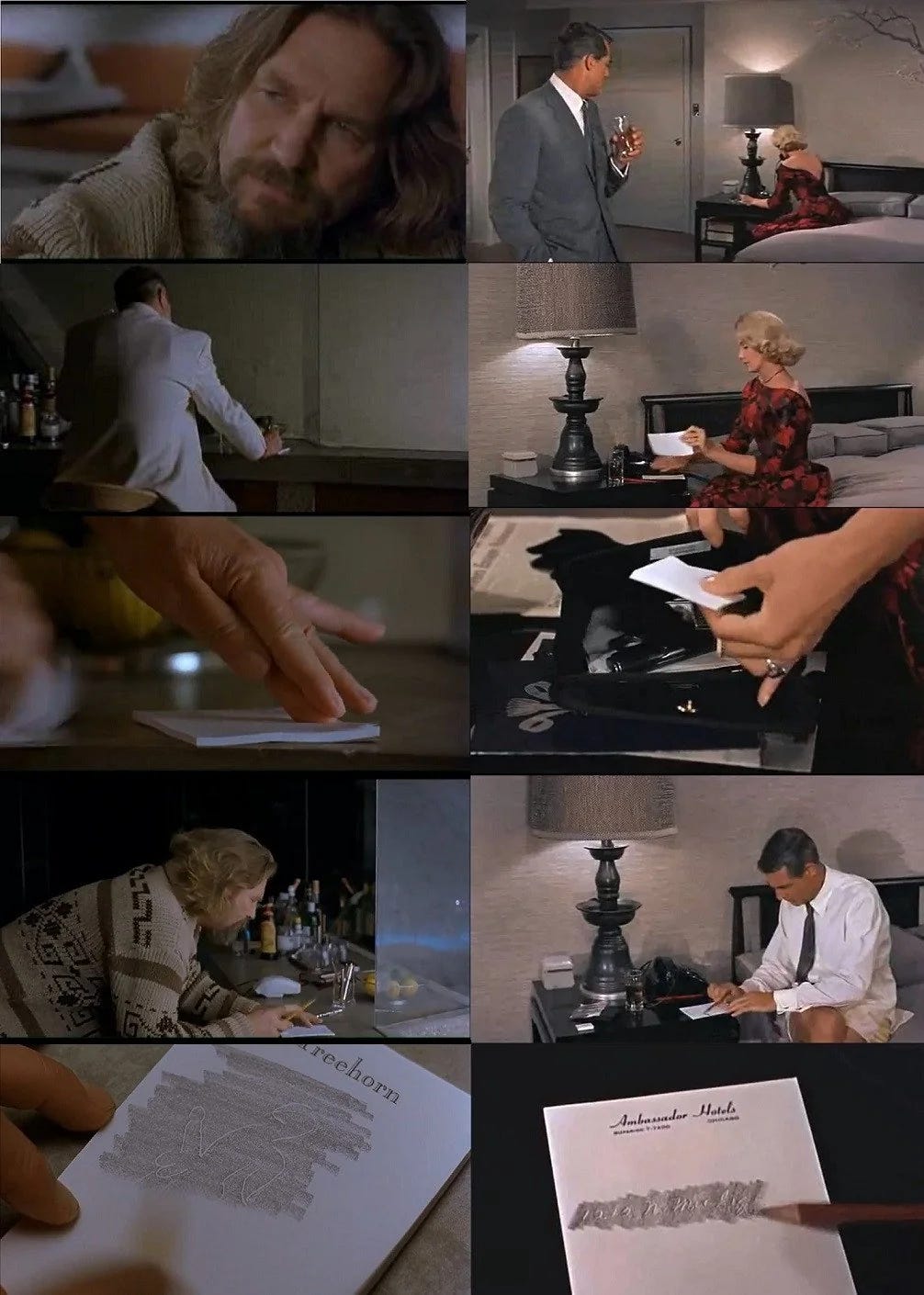Passionate Kisses
I can trace back to where certain musical preferences were born. For instance, listening to the oldies station on the way to kindergarten gave me an appreciation for classic pop song structure and length. I love a song that gets in and out in under three minutes. Motown is what I remember most from those school bus days.
Other musical preferences or connections are sometimes more challenging to pin down. For instance, the guitar riff in “God Blessed Texas” quotes from “Back In My Arms Again” which is also quoted in the bridge of “Small Town.”
Specific musical phrases get passed down, and musicians use them to tell you their tastes and how much they know. It’s the same in film such as in The Big Lebowski, The Dude (Jeff Bridges) rubbing the pencil to reveal what Jackie Treehorn (Ben Gazzar) scrawled is an allusion to Roger Thornbill (Cary Grant) doing something similar in North by Northwest to see what Eve Kendall (Eva Saint Marie) has written on a pad.
The “Be My Baby” drum intro is a classic example: “Just Like Honey” by The Jesus & Mary Chain, “What You’re Doing” by The Beatles, “Say Goodbye To Hollywood” by Billy Joel — fittingly covered by Ronnie Spector — and many more.
The Velvet Underground’s “There She Goes Again” quotes “Hitch Hike” by Marvin Gaye as does “There Is A Light That Never Goes Out” by The Smiths.
“Feel” by Big Star has a progression similar to Marvin Gaye & Tammi Terrell’s “You’re All I Need To Get By.” Listen with some intentionality, and you’ll begin to notice those connections.
In the last year I’ve realized that my preference for jangly guitars can be traced back to my mother. While I’ve primarily filled the role of the music-savvy older brother or hip uncle to expand my musical taste, what my mother listened to when I was at an impressionable age left a lasting impact.
For instance, I will always have a soft spot for 90s country because that’s what she listened to then, either on the radio or on CDs. Her collection was filled with Garth Brooks, Alan Jackson, George Strait, and other stalwarts of that era. I have a soft spot for some early Toby Keith songs like “Should Have Been A Cowboy.”
That song means a lot more to me now that I’ve I know who Gene Autry and Roy Rogers were, to say nothing of my love for westerns. When I was younger, I fancied myself a little cowboy; I wore fake spurs made of plastic zip ties on my black boots. I believe it was my maternal grandfather who installed those. He also wrote “L” and “R” in the tag of the little boots to help me remember which one went on which foot. He also purchased several Teenage Mutant Ninja Turtle shirts so my parents no longer had to wash those shirts every night because I refused to wear anything else. We were living in Grants Pass, Oregon at the time and we owned horses. I had my own pony, which I named Baby Pony.
When my dad walked out on my mom, she listened to “Does That Blue Moon Ever Shine on You” all the time. And while I hated his jingoistic tunes like “Courtesy of the Red, White And Blue (The Angry American)” or pandering stuff like “American Soldier” I enjoyed stuff like “How Do You Like Me Now?,” “Beer For My Horses,” “I Love This Bar,” and “Who’s Your Daddy?” Listening to those songs makes me think of riding in the back seat of my mom’s white Chevy Astro van.
And now that I’m older and more knowledgeable, “Bigger Than The Beatles” by Joe Diffie means more to me, like the backing vocals on the fadeout that are similar to the vocals on “She Loves You.” “Time Marches On” by Tracy Lawrence has more significance because I know and love “Kaw-Liga” and “Dear John” and, of course, “Like A Rolling Stone.” This grounds me because there is a continuity between what I heard growing up and what I came to love as I began to assert my own identity and taste.
My country listening skews older; I will forever want to close up the honkytonks, I love to harmonize with Patsy Cline on her heartache-filled countrypolitan songs, and I sing my way back home with the sound of Bakersfield, sometimes that comes via The Beatles covering Buck Owens, the Stones doing a parody with Far Away Eyes or I turn to the source. “Buckaroo”remains one of my favorite instrumentals.
But I also listen to the songs I grew up with. I tend to like the Neo-Traditionalists. Their approach to songcraft and structure stays close to their influences, but the production is more modern.
And like anyone who spent time DJing at a college radio station, I have familiarized myself with alt. country, the kind that used to get written up in No Depression. And country-rock like Gram Parsons and related acts is a big part of that. And then there’s The Beatles.
The reductive approach to describing the difference between them and the Stones is that the Beatles were influenced by rockabilly country music. The genre was so popular in that port town that it was nicknamed the Nashville of the North and not just because none of the famous musicians who called it home was shot by a glasses wearing fan. Try to forget that line if you’ve not yet seen Robert Altman’s masterpiece Nashville.
And The Stones are a blues band, beholden to Chess, Stax, Atlantic and other classic blues and soul labels. Some would even use The Beatles and Stones as a means of highlighting the differences between Motown and Stax. And while true to a point, ultimately too reductive.
The Beatles and Stones both covered Chuck Berry, Buddy Holly, and Arthur Alexander. And while there are characteristics that differ country music from the blues, they are ultimately rooted in a foundation of folk music, such as the Child Ballads played and remembered in Appalachia, gospel music in Black churches, or jazz in the demimonde of Storyville in New Orleans.

Many early jazz, country, folk, blues, and gospel songs were recorded in Gennett Records in Richmond, Indiana. Louis Armstrong did his first recordings there. “Stardust” was written by Hoagy Carmichael. Booker T. Jones split his time between Memphis and Bloomington in the 60s, working on a degree in music during the week and returning to Memphis to record and perform. I’ve known this fact for years and still can’t wrap my mind around the idea of him studying third species Fuxian countrpoint and laying down tracks with Otis Redding. These are some of many examples of why I believe Indiana is secretly one of the most important states in the country.
“I don't know what it is about Hoosiers. But wherever you go there is always a Hoosier doing something very important there,” Kurt Vonnegut, Cat’s Cradle.
Ethnomusicologist Alan Lomax knew that when he gathered recordings of people around the country. The Harry Smith-curated Anthology of American Folk Music truly showcases the breadth and depth of music created in the U.S.
I have a hunch my appreciation for jangly guitars comes from “Passionate Kisses” by Mary Chapin Carpenter, a single released in 1993. I wasn’t aware until quite recently that it was a Lucinda Williams cover. Williams is, of course, a major figure in the world of alternative country and one of my favorites. “Sharp Cutting Wings (Song to a Poet)” is a masterpiece.
When I began to seriously explore music on my own, the seeds planted by that classic song began to sprout. There are some of the early Beatles songs that feature a jangly guitar, like many of the tracks on A Hard Day’s Night. Seeing George Harrison play a 12-string Rickenbacker inspired Roger McGuinn to purchase one of his own. The sight of a Rickenbacker is enough to convince me to give a band a try.
McGuinn’s sound came from using banjo plucking techniques to play arpeggios on his guitar. The term jangle pop derives from a lyric in Bob Dylan’s “Mr. Tambourine Man,” “Hey, Mr. Tambourine Man, play a song for me/In the jingle jangle morning I'll come following you.” And that cover, along with “Turn! Turn! Turn! (To Everything There Is A Season),” are the signature tunes of The Byrds and define their early sound.
There’s an argument to be made that outside of The Velvet Underground, The Byrds are the most influential American band. Just off the top of my head, genres The Byrds significantly influenced include jangle pop (obviously), power pop, country-rock, psychedelic rock, and folk rock. To get more granular, many of the significant alternative acts of the 1980s owe a debt to The Byrds. Groups like R.EM., The Smithereens, Guadalcanal Diary, The Bangles, The Long Ryders, and many others.
And to return to Dylan, one of his major influences is The Anthology of American Folk Music. He borrows imagery and lyrics from so many songs. To understand Dylan, if such a thing is possible, one must know Hank Williams, Buddy Holly, Woody Guthrie, Muddy Waters, and The Anthology of American Folk Music at minimum. Ultimately, it’s all one note, you just have to listen carefully.






